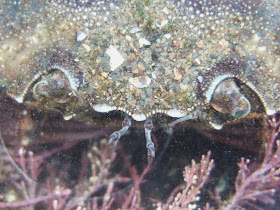The Beadlet Anemone Actina equina belongs to the phylum Cnidaria, being a relative of the jellyfish and corals. It is well adapted to being left high and dry between tides, and it can tolerate fairly high temperatures and dessication without a problem. Outside the water they look like nothing more than lifeless blobs of jelly clinging to the rocks, but once submerged a beautiful rosette of tentacles gives them their flower like appearance.
 Beadlet Anemones are the main food source of the Common Grey Sea-Slug Aeloidia papillosa, whose eggs can be seen here. The sea-slug can transport the undigested stinging cells from the anemone's tentacles into the fleshy outgrowths (cerata) on it's back, where it can use them for it's own self defence.
Beadlet Anemones are the main food source of the Common Grey Sea-Slug Aeloidia papillosa, whose eggs can be seen here. The sea-slug can transport the undigested stinging cells from the anemone's tentacles into the fleshy outgrowths (cerata) on it's back, where it can use them for it's own self defence.
The Shore Crab Carcinus maenas is the most common British crab. It's the one all the kids haul up on their crabbing lines down by the swing bridge. Here is a view of the face of a rather large and fierce specimen found under a rock at Sandsend. Notice the mobile eyes and the antennules with their tiny pincers used to help pass food to the mouthparts.

The brittlestar Amphipholis squamata is an echinoderm related to the starfish and shares it's five fold symmetry. Unlike the starfish it doesn't glide along on a system of thousands of tiny tube feet. Instead it moves by sinuous movements of it's long slender arms, as illustrated in this rather fuzzy video.
beadlets are beautiful, i had a few as a pet and then they had babies
ReplyDelete